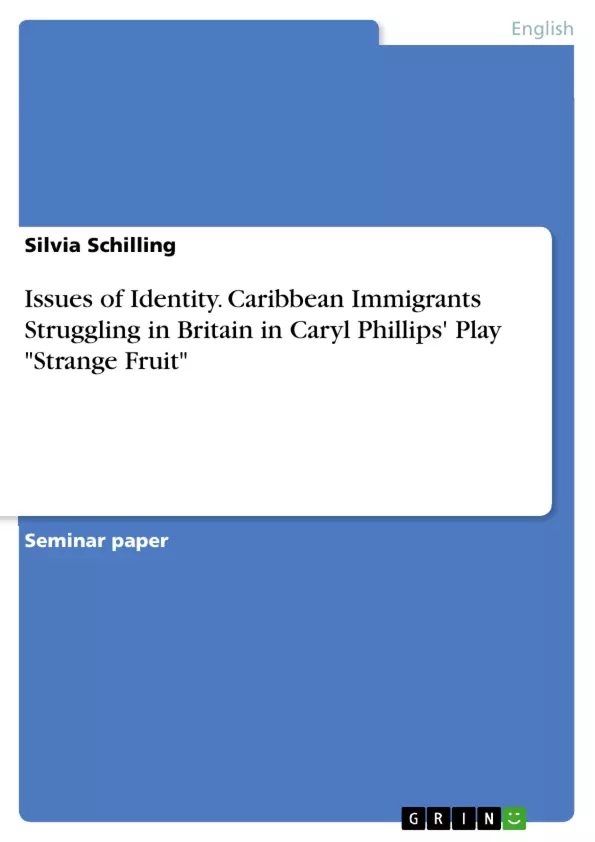This term paper analyses identity conflicts of the Caribbean immigrants struggling in Great Britain in Caryl Phillips´ play "Strange Fruit". First, the term ´identity´ is defined and the historical background concerning Caribbean immigration in Great Britain and Pan-Africanism is provided. Then, the identitiy issues of the play´s immigrants are discussed. This discussion includes the first-generation immigrant Vivien Marshall as well as the second-generation immigrants Errol and Alvin, Vivien´s two sons. Notions such as "playing white" and "playing black" as well as illusions and disillusionment are presented and analyzed in detail.
Inhaltsverzeichnis (Table of Contents)
- Introduction
- Theoretical Background: What is "Identity"?
- Historical Context
- Caribbean Immigration in Britain
- Pan-Africanism
- Issues of Identity in Strange Fruit
- First-generation Immigrants: Vivien Marshall
- Vivien as a Mother
- "Playing white"
- Second-generation Immigrants: Errol and Alvin Marshall
- Errol Marshall: "Playing black"
- Errol's Illusions
- Alvin's Disillusionment
- Objective Identity vs. Subjective Identity
- First-generation Immigrants: Vivien Marshall
Zielsetzung und Themenschwerpunkte (Objectives and Key Themes)
This paper aims to explore the complex issues of identity among Caribbean immigrants in Great Britain, particularly focusing on the play "Strange Fruit". It will examine the concept of identity from a theoretical perspective, analyze its historical context, and then delve into the specific experiences of the characters in the play.
- The construction of identity in relation to immigration and societal perceptions
- The influence of history and sociology on identity formation, particularly among first and second-generation immigrants
- The impact of discrimination and assimilation pressures on the identity of immigrants
- The distinction between subjective and objective identity and their interplay in shaping an individual's sense of self
- The search for origins and the role of ancestry in identity construction
Zusammenfassung der Kapitel (Chapter Summaries)
- Introduction: This chapter introduces the topic of immigration and its impact on both the receiving country and the immigrants themselves. It highlights the importance of understanding the struggles of identity faced by immigrants, particularly Caribbean immigrants in Britain. The paper then outlines its scope and purpose, focusing on the play "Strange Fruit" as a case study.
- Theoretical Background: What is "Identity"?: This chapter delves into the definition of "identity" by exploring different perspectives from dictionaries and scholars. It differentiates between subjective and objective identities, explaining how they are interconnected and influence each other. The chapter further examines the social construction of identities, particularly focusing on race and gender, and how societal perceptions impact self-perception.
- Historical Context: This chapter provides a historical background on Caribbean immigration in Britain and the rise of Pan-Africanism. It sets the stage for understanding the context in which the play "Strange Fruit" takes place and the experiences of the characters it portrays.
- Issues of Identity in Strange Fruit: This chapter focuses on the play "Strange Fruit" and its portrayal of identity struggles among the characters. It analyzes the experiences of the main characters, Vivien Marshall (first-generation) and her sons Errol and Alvin (second-generation), highlighting the different coping mechanisms and challenges they face in navigating their identities.
Schlüsselwörter (Keywords)
This work explores the intricacies of identity construction within the context of Caribbean immigration in Britain. The main focus is on the play "Strange Fruit" and the interplay of subjective and objective identity, assimilation, discrimination, and the search for origins. The analysis employs theoretical concepts, historical context, and sociological insights to understand the complexities of immigrant experiences.
- Quote paper
- Silvia Schilling (Author), 2015, Issues of Identity. Caribbean Immigrants Struggling in Britain in Caryl Phillips' Play "Strange Fruit", Munich, GRIN Verlag, https://www.grin.com/document/450250



